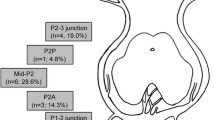Background.
The present retrospective analysis was undertaken to review an institutional experience with 13 intracranial dissecting aneurysms as source of subarachnoid haemorrhage (SAH) among a total of 585 ruptured intracranial aneurysms.
Methods and results. In 6 patients the vertebral artery (VA) was affected, in 2 patients the basilar artery (BA), in 3 the internal carotid (ICA), in 1 the middle cerebral (MCA) and in 1 the postcommunicating (A2) segment of the anterior cerebral artery (ACA). Maintaining arterial patency was aimed at in all patients. Tangential clipping or circumferential wrapping were used as surgical methods. Endovascular stenting and/or coiling was applied in 2 instances. Four of the 6 VA dissecting aneurysms underwent surgical exploration between 1 and 22 days after haemorrhage. Two patients were in WFNS grade V and died subsequently with the aneurysms untreated, one after rehaemorrhage. In the patients with secured VA aneurysms the postoperative course was uncomplicated with the exception of additional caudal cranial nerve injury in 1 instance. Both BA aneurysms were initially treated by endovascular methods. In the first patient incomplete packing with Gugliemi detachable (GDC) coils was achieved. Follow-up angiography 6 months later showed growth and coil compaction and subsequent wrapping with Teflon fibres resulting in angiographic stabilization. The other BA aneurysm was treated by a combination of a coronary stent and GDC coils. The 3 dissecting ICA aneurysms were all explored surgically. In only 1 instance ICA continuity could be preserved by wrapping, in the other 2 cases a major portion of the vessel wall disintegrated upon removal of the surrounding clot. The only ACA dissecting aneurysm, on A2, was successfully treated with a Dacron cuff. In the single patient with a MCA aneurysm, a decision for conservative management was taken, because neither a surgical nor an endovascular solution was seen as a possibility that did not risk occlusion of lenticulostriate branches. The patient suffered a fatal rehaemorrhage 4 weeks later at her home.
Conclusions. The reported experience suggests that in Western countries also dissecting aneurysms are an occasional source of SAH. The outcome in our conservatively managed patients confirms the poor prognosis of conservative management. Wrapping and endovascular stent based methods can achieve stabilization of the dissected artery without sacrificing the artery. Results of treatment appear to depend largely on the location of the dissecting aneurysm.
Similar content being viewed by others
Author information
Authors and Affiliations
Rights and permissions
About this article
Cite this article
Uhl, E., Schmid-Elsaesser, R. & Steiger, HJ. Ruptured intracranial dissecting aneurysms: management considerations with a focus on surgical and endovascular techniques to preserve arterial continuity. Acta Neurochir 145, 1073–1084 (2003). https://doi.org/10.1007/s00701-003-0122-2
Received:
Revised:
Accepted:
Published:
Issue Date:
DOI: https://doi.org/10.1007/s00701-003-0122-2




